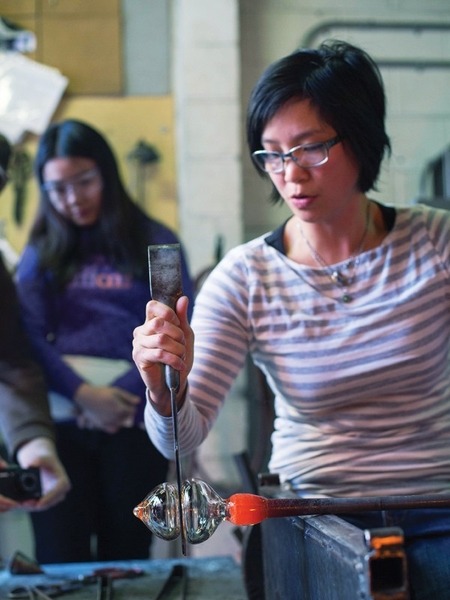Seeing Glass in Another Light
-
-
slice.mit.edu
- 2
Filed Under

Recommended
Helen Lee '00 works with glass as an artist, but thanks to her years at MIT, she also sees the medium the way a scientist does.
“Most people think of glass as a material—something physical you can point to,” Lee says. “I enjoy it from a materials science standpoint, where glass is defined as a state of matter.”
Her formative period in the glass lab was a central part of Lee’s MIT experience. “When I was accepted to MIT, there was no question I would attend. But in some ways I didn’t feel like I belonged,” says Lee, whose parents were more set on her coming to MIT than she was initially. “But when I spent time in the Glass Lab, it made up for my sense of not feeling like I should be there.”
Lee first became interested in glass when she attended a summer art camp at age 16, and her time as an MIT undergraduate coincided with a massive growth in popularity for the Glass Lab. Under the leadership of director Peter Houk, the lab grew from a small collection of students in the basement of Bldg. 4 into one of the most popular extracurricular activities on campus.
“I was so lucky to be part of the lab’s early momentum,” says Lee, who took her first glass courses during IAP. “Peter saw how many students were interested, and he worked to make it more available.”
Video profile courtesy of University of Wisconsin, Madison
After MIT, Lee earned her master of fine arts in glass from the Rhode Island School of Design. She spent time in California as a graphic designer, typesetter, and freelance glass artist whose work uses words and language as metaphors for boundary and transformation. She returned to MIT’s Glass Lab as an artist in residence during the spring 2013 semester.
Her works have included Pillow Book, a glass funereal pillow inscribed with people’s recounted dreams of her, and OMG, a neon pink glass sign of the Chinese expression for “Oh my God,” which literally translates to “My day.”
“Both glass and language have dualistic qualities that pair well,” she says. “Glass can hold light in the same way we ask words to hold meaning.” Lee is now an assistant professor at the University of Wisconsin, Madison, where she is head of glass in the art department. She draws inspiration from her MIT classmates, peers, and researchers to lead the university’s glass lab.
“The best thing I can offer my students is the people I know and expose them to,” she says. “At the end of the day, my peer group from MIT are among the smartest people in the world.”
This article originally appeared in the March/April 2017 issue of MIT Technology Review magazine.








Comments
Joe Atkinson
Fri, 03/31/2017 4:41pm
Is the underlying chemistry of different types of glass understood/explored? This could help to design glass of various properties.
I am an organic chemist, so this is off my expertise.
Gordon Freed
Wed, 03/29/2017 9:35pm
By extraordinary chance, I was in the first glass lab during IAP Jan, 1974. One of the most memorable experiences at the Tute. Taught by Pam Vandiver, who had a degree in ceramics from RISD.